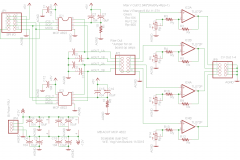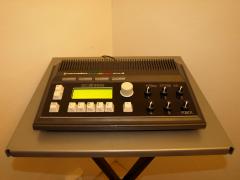
yogi
Members-
Posts
218 -
Joined
-
Last visited
-
Days Won
5
Content Type
Profiles
Forums
Blogs
Gallery
Everything posted by yogi
-
port LPC1343 polysynth to MBHP_CORE_STM32F4?
yogi replied to tffshtt's topic in MIDIbox User Projects
Thanks :) Will be trying this out soon, got a R Pi 2 a week ago and waiting on a HDMI to VGA dongle. Also got a Logitech USB audio dongle, at some point will upgrade to the HiFiBerry DAC+ but kind of want to see what can be done on the cheap. Yogi -
Very well done. VGM support is huge, not just for playback of existing game files but also for new arrangements composed on cross platform tools like Deflemask and VGM Music Maker. And Yes one could use flash carts for VGMs on original consoles but the functionality you've added is very useful even now with your first release :) Yogi
-
Problems running app on new STM32F407G-DISC1 pcb
yogi replied to illogik's topic in Testing/Troubleshooting
I think you are right with the solution of holding the ST-LINK/V2 in reset. I had seen this feature on the STM page: but with no mention of the limitation you quoted ( no big surprise, as I'm sure others using the Disco boards are not real happy with the change.). Perhaps the LINK V2 is waiting for re-enumeration for one of it's modes and stalling MIOS from booting ? At least the workaround is easy; and once the bootloader is installed the ST-LINK isn't needed any longer. Yogi -
Very good that you found the problem's solution, seems this answers some of the questions that have been asked as to the changes between the older 'F4 DISCOVERY and the newer 'F407 DISCOVERY boards. This will be of interest to the whole community for all new builds :) Yogi
-
Just another thought. Your USB OTG cable, does it have two microUSB plugs? If that is the case then it's a A/B cable, meaning that one end is a A plug and the other is a B plug, and either will plug into a microUSB socket. The type of plug that is inserted into a OTG socket signals the device which mode it should run as. So if you plug in the B end on the STM it will assume the Device mode but if you connect the A end the STM will run as a Host. The microUSB cables I have (not OTG types) are marked "B" in the plastic, so a proper A/B cable will probably be clearly marked also. Yogi
-
port LPC1343 polysynth to MBHP_CORE_STM32F4?
yogi replied to tffshtt's topic in MIDIbox User Projects
Very cool. PD is a great choice; open source cross platform tools are very welcome. I like your R Pi setup as well as your Moon Box :) Haven't gotten into the R Pi but very temped ( SunVox, Milky Tracker, retro EMUs; so many interesting directions); just trying to get over the 'sticker shock' for the touch screens (pushes the cost up to that of a used IPad 1 or 2). For a 'Ghetto' build maybe a HDMI to VGA adaptor and a second hand VGA monitor. At least till I feel comfortable buying a TS setup. Looking forward to your patch, Yogi -
Welcome Andre :) I'm afraid you won't be able to use the Midibox code with the F411 board, it's not supported. Your best bet is to just get a STM32F4 Discovery board. You will save yourself a lot of problems, as the F411 is a less advanced chip that lacks features that are used on the F407. The MIOS libs that support the Goom port are specific to the F407 and will not run on the F411. Nothing short of rewriting the MIOS package will be required. From my point of view, the manhours need to port to a different board far outweighs the $25 for a Discovery board. Yogi
-
First of all, Welcome :) Good to have you here. I'm not really the best to answer your question, but I'll try. As I understand, CN5 can power the board via a USB source( via the PA9 to +5V jumper) when the STM is in Device mode but you need to supply power from an external source when CN5 is in Host mode, as the STM board will try to supply power to the Device that connects to it. Not sure about your tablet/pad, does it connect to the STM as a Device or a Host? Does the STM show up/boot when plugged into a laptop, powered via CN5? EDIT: I see you tried using a USB wall wart on CN1, Did you try power block to CN1 without the PA9-to-+5V jumper? See J2 and J17 on http://ucapps.de/mbhp/mbhp_core_stm32f4.pdf I hope someone will have a better answer, but I would try setting up an external +5V source to J2 such as noted on the MB CORE_STM32F4 page http://ucapps.de/mbhp_core_stm32f4.html A wall wart from a USB hub should work as long as it is rated at +5V @ 500mA, a higher amperage would be ok but it must be +5V. Be sure on the polarization when connecting, double check with a multimeter. Or you may try finding a 'USB charger' wall wart with the mini-USB connector for CN1 to supply the board. Yogi
-
Stunning Demo! The only down side, It's so beautiful to watch one overlooks the great sound :) Yogi
-
Very amazing work 8) And I've noticed your uploads to the SVN. Just fantastic. Just last week I got boards from Smash, can't wait to start but a little time limited atm. Yogi
-
W O W!!!! Just Fantastic. (speechless ATM) Yogi
-
\o/ Something new over @ AVI Showtech, Thanks Smash :) Can't wait to spend some $$
-
OK very good, I'll keep an eye on it
-
OOOOH, yes DRM raises its head :) At any rate, streaming VGM is very impressive! Can't wait to see the improved version. Yogi PS is there any word from SmashTV on the boards (or is that left to him)? Been checking his site daily
-
Awesome work, Not sure what happened to the vid but it was there a little while ago. Hope you post it back up Sauraen, very impressive! Yogi
-
Hi Matthias, yes there is so much that can be done with MIOS32 and STM. The USB host mode is the 'cherry on top'. I only pointed out that chip as an option for people having to choose when wanting to support a USB device AND maintaining the MIOS Studio/PC USB connection :) Plus it could be useful for older Core 8 projects. Yogi
-
Hello Matthias, I'm sorry I can't help with your problem directly. But I've just run across an interesting product that offers a 'have your cake and eat it too' solution to the host mode midi function. In another forum someone pointed this chip out- http://www.hobbytronics.co.uk/usb-host-dip USB Host midi on one side and TTL serial midi on the other. At 5 pounds for the bare chip, It's a little on the spendy side compared to the STM host mode; but using it with one of the STM's midi ports would provide a very simple bridge without losing the PC midibox studio link. For that matter, would work on a PIC core project also. Just a thought, Yogi
-
:) :) KICKS *s
-
Welcome Lamster,and Happy New Year. I don't know if you've checked out the MIDIfication forum, the posts in that forum are exactly what you are interested in doing, modifying keybeds and organs using the MIDIbox KB project or the NG code. And Fatar keybeds are very popular so you should find alot of help. You'll need to read over the Wiki page Really this forum, User's Projects, is for user's WIP projects that don't fit in with one of the 'Official' projects. Again Welcome aboard, Yogi
-
Looks Very nice! Will be looking forward. Yogi
-
So, here is my first pass at a dual MCP4822 DAC schema. Pretty much just doubled up TK's design. Will be laying out the brd and doing a run @ OSH Park soon. Any feedback would be welcome, Yogi
-
So weird :) just the other day I ordered some of these, wanting to do a simplified (cheap) MIOS8 CV1 to drive a Arduino based Eurorack project, Talko LPC speech synth http://elek101.blogspot.com/2014/10/talkie-eurorack-module-part-1-concept.html . Any hope for support of 6 CV channels (3 CS pins)? Yogi
-
Sounds good:) I'll be in for 2 bare boards when you're ready. Yogi
-



